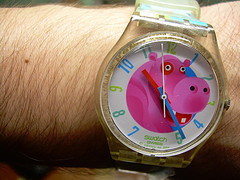Activities That Ask Students to Explore Cultural Mindsets
August 18, 2010
 This week’s release of the Beloit List got me wondering about how the resource might be used in class.
This week’s release of the Beloit List got me wondering about how the resource might be used in class.
Officially known as the Mindset List of the Class of 2014, the Beloit List has been published each August for the last 13 years to remind us teachers of the cultural knowledge that first-year college students bring (or don’t bring) to the classroom.
This year, we’ve learned that the incoming class thinks Barney is a dinosaur rather than a Mayberry Deputy, telephones have never had cords, and wrist watches are not part of their wardrobe. Or at least that’s what the list wants us to believe.
The Chronicle of Higher Education published an article yesterday that explored the background of the list. Tom McBride and Ron Nief, “The Minds Behind the Mind-Set List,” explain:
the list started on a lark back in 1997—some old college hands unwinding on a Friday afternoon, musing on how much freshmen don’t know about recent history and culture. But such blind spots are to be expected, they had agreed, given the relative youth of the incoming class. They had concluded that professors should be mindful of how very different their students’ life experiences are from their own.
What struck me when I read The Chronicle article though was the picture of the lists creators. There they were. Two, white-looking, men. I couldn’t help but wonder how the lists might be different if the authors were, to put it politely, a bit more diverse.
What began as that little curiosity turned into this short list of ways that you might use the list in class:
- Analyze the list for diversity. Think about race, gender, and ethnicity. What’s missing? How would you revise the list to be more accurate.
- Consider the accuracy of the list. Take one of the items on the list and do a little research to see how correct it is. Anecdotal research and simple surveys would be enough. For instance, observe people in the library or dining hall and count the number who have on a wrist watch. Think of yourself as on a mission to bust myths and misconceptions.
- Share your personal mindset, using the Beloit List as a model. What cultural markers do you consider important? Are there things that have always been a part of your life (or have never been)?
- Create a list for a historical figure or fictional character. The list should clarify how the world of the figure or character is different from that of today. For instance, Chaucer’s pilgrims never had indoor plumbing and travel was normally by foot or by horse. Pop culture figures would work as well (e.g., characters from television series or movies).
- Gather a list on the cultural mindset of a different social group—veterans who served in Afghanistan, working mothers, or firefighters, for example.
- Refocus the list to outline 5 to 10 items that fit the topic “I live in world where . . .” Try to think of specific details that communicate how your world differs from that of others in the incoming class. Use the list to show how you’re different.
- Satirize the list with an irreverent collection based on a more humorous touchstone. How about “ever since I got a job” or “since I’ve been on a diet”?
The language of the Beloit list is an easy model to follow, and many of these activities can be a fun community building activity.
And speaking of fun, I know it’s a terrible stereotype, but I really want to write a list that begins “Ever since we started dating, the cap has always been on the toothpaste, the toilet seat is always down, and my dirty socks are usually in the laundry basket.”